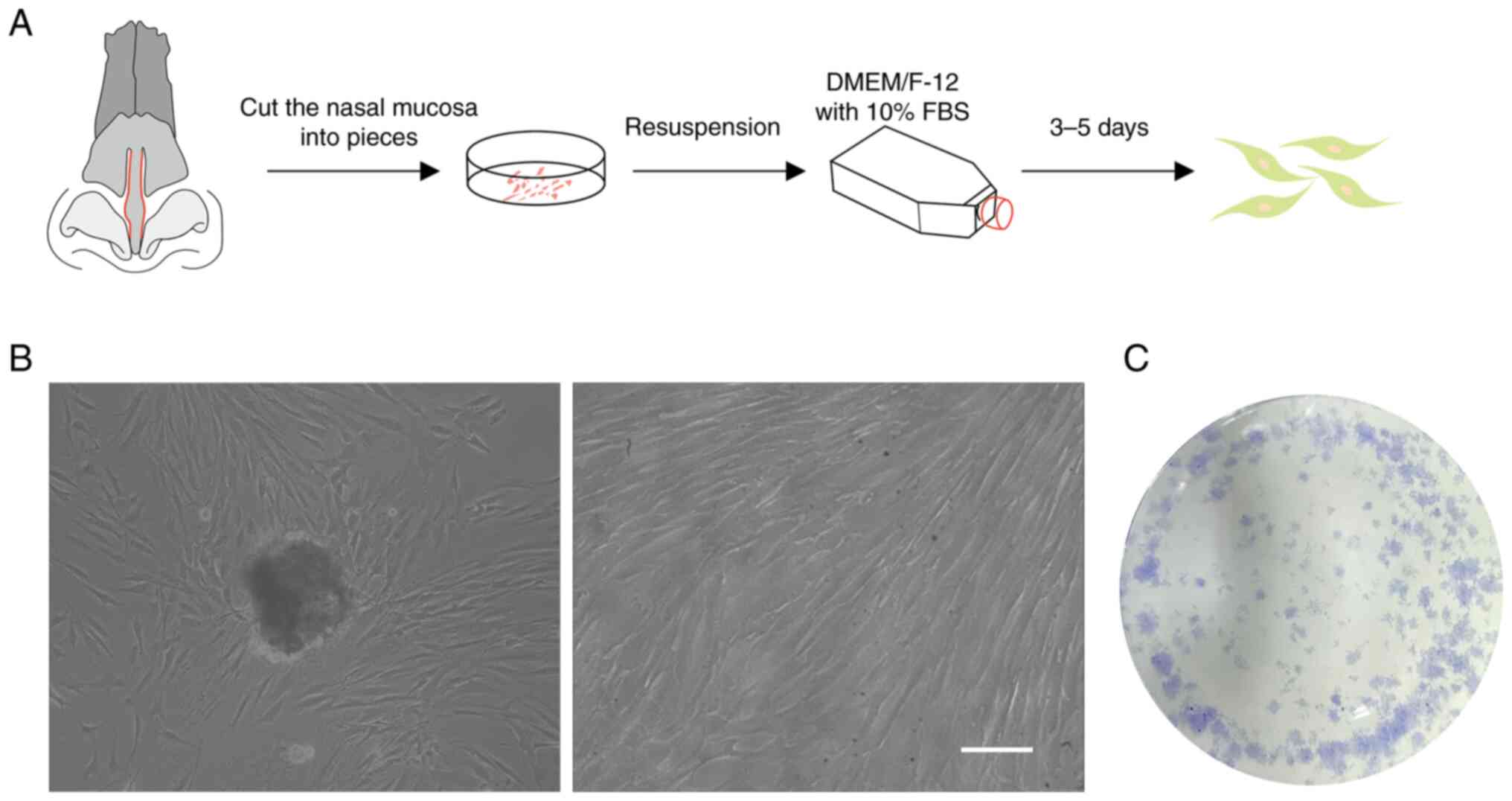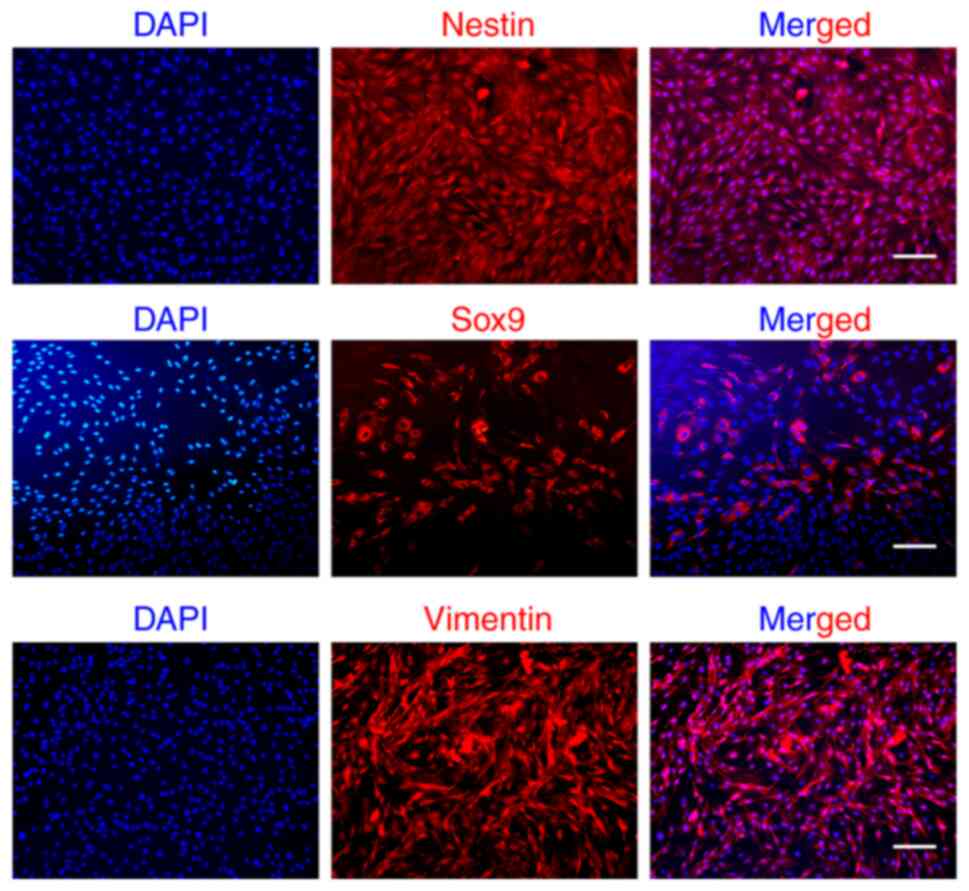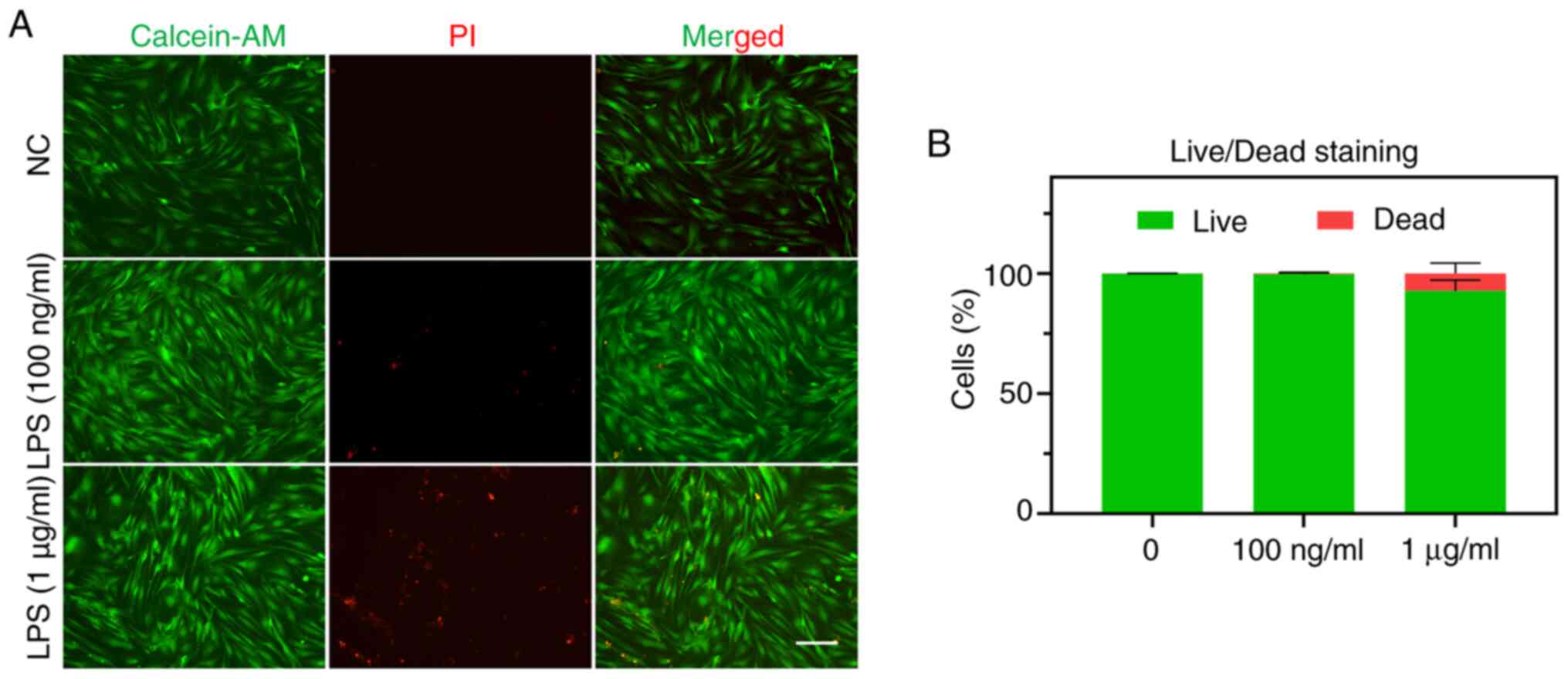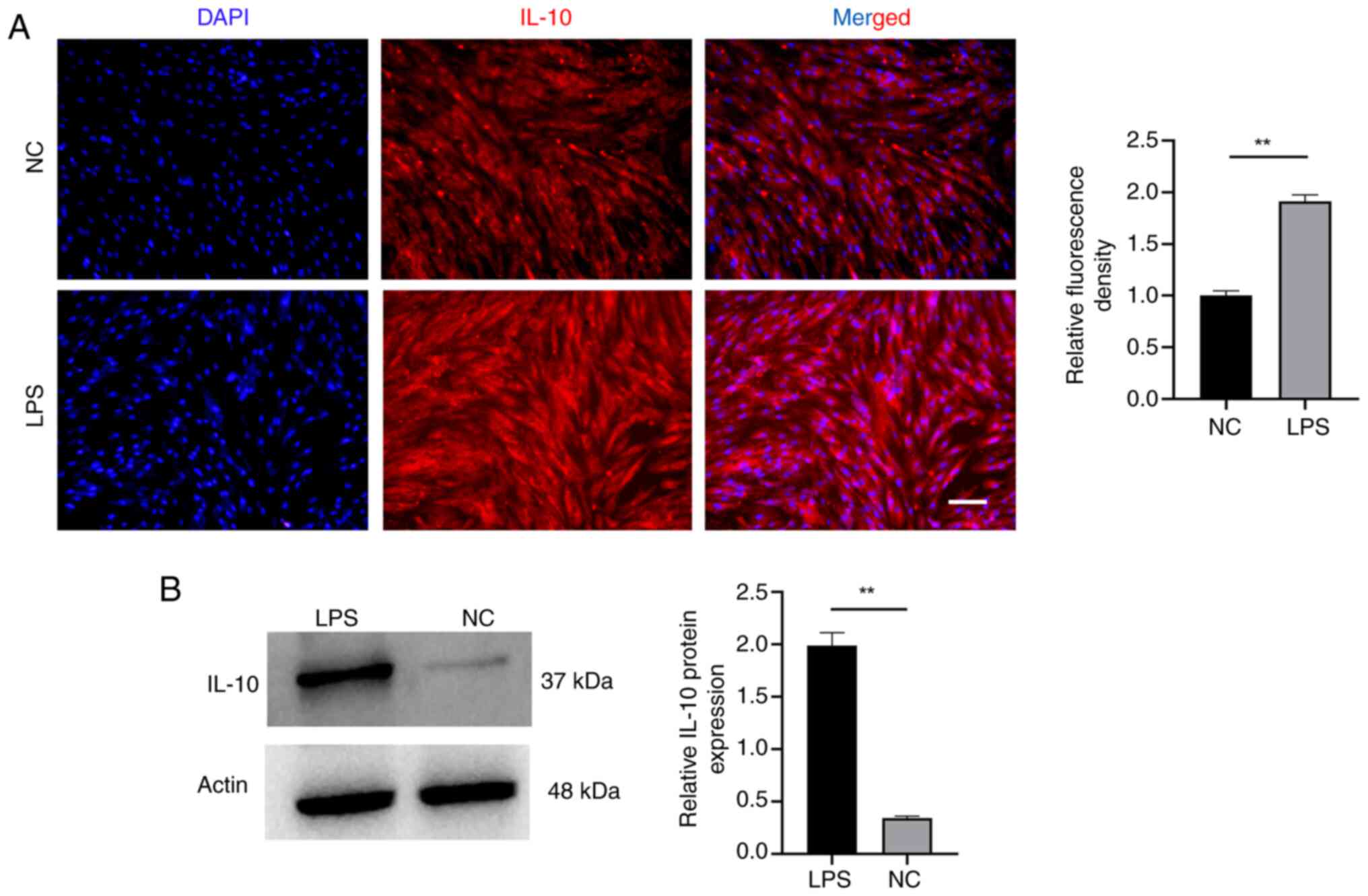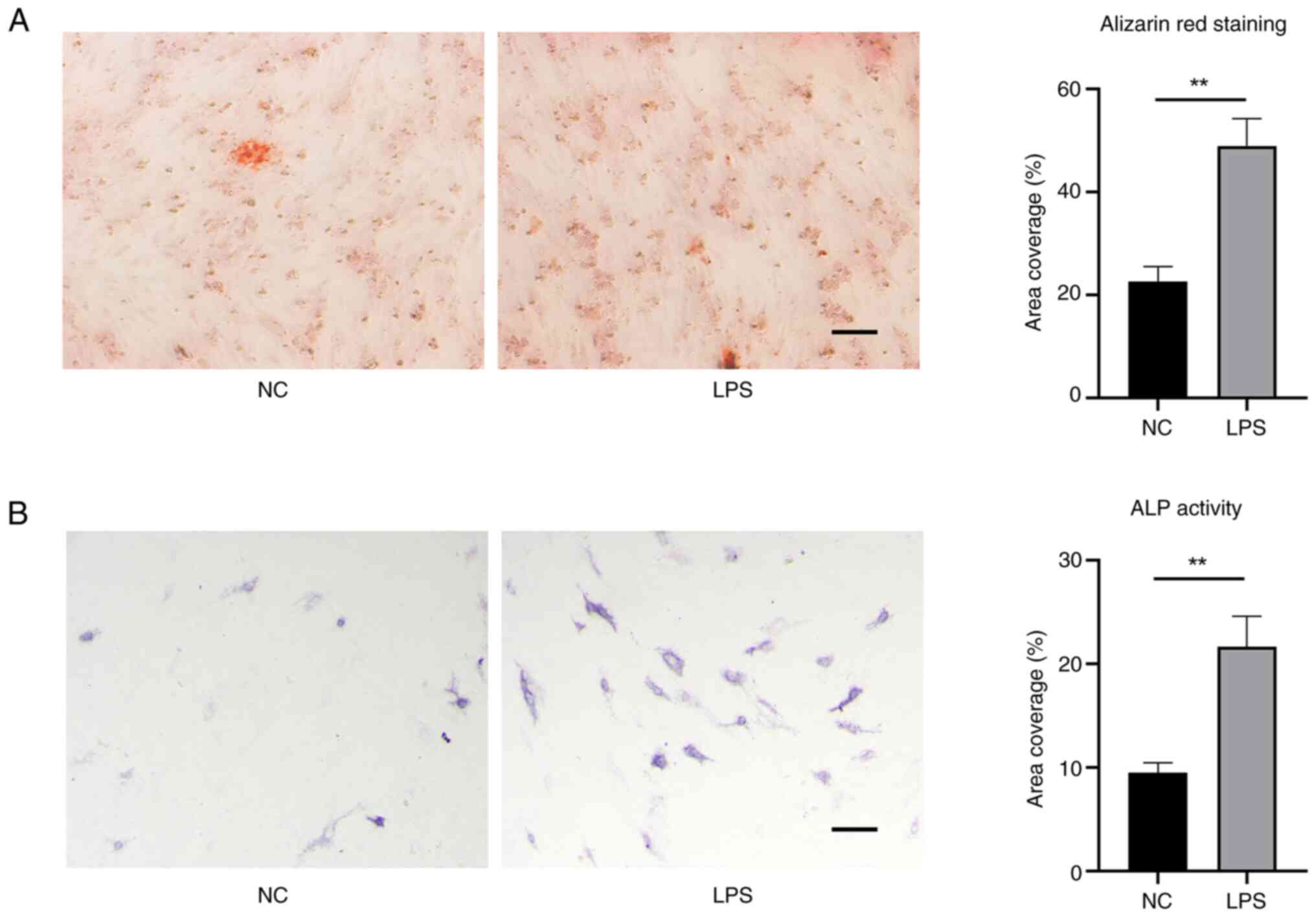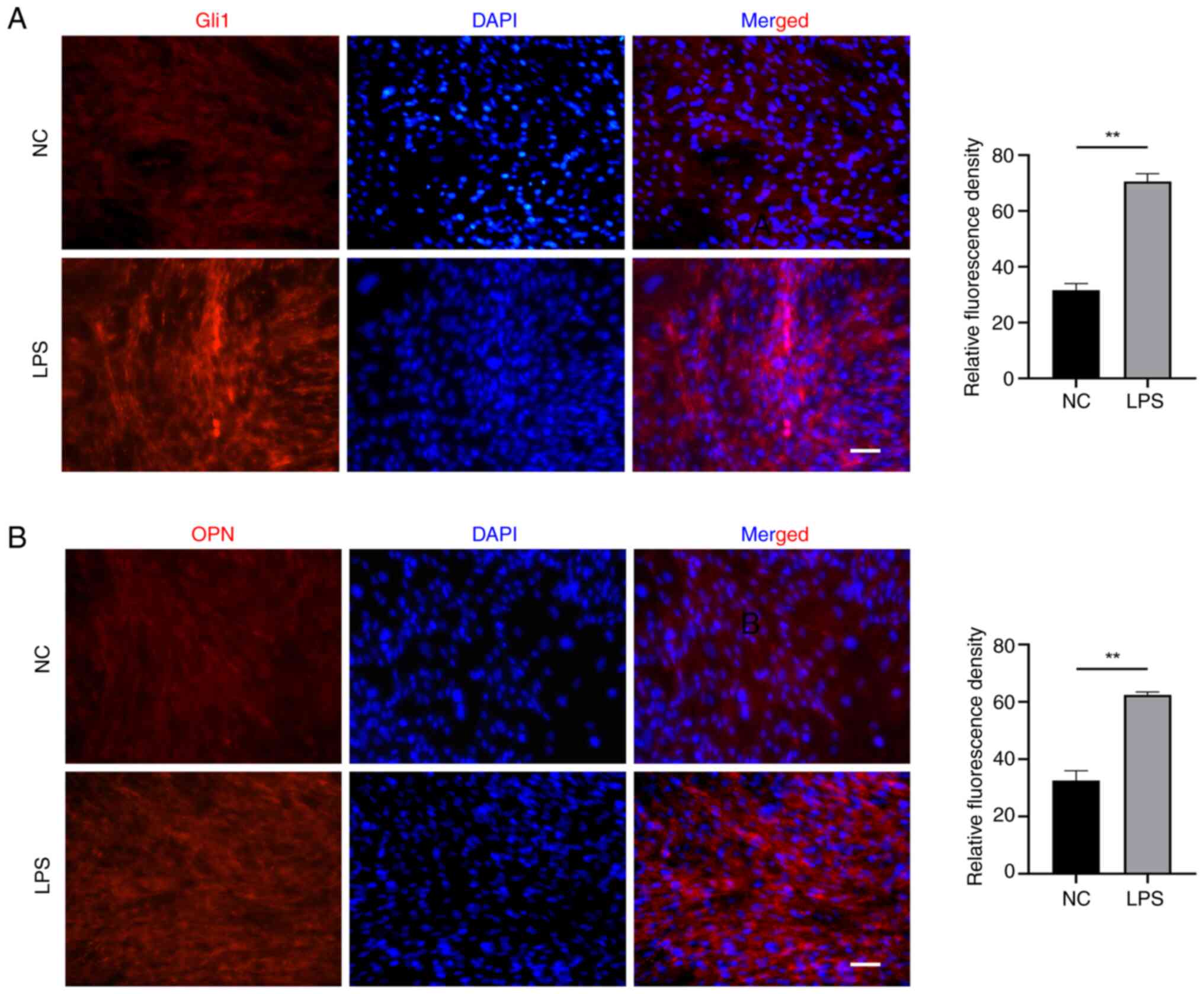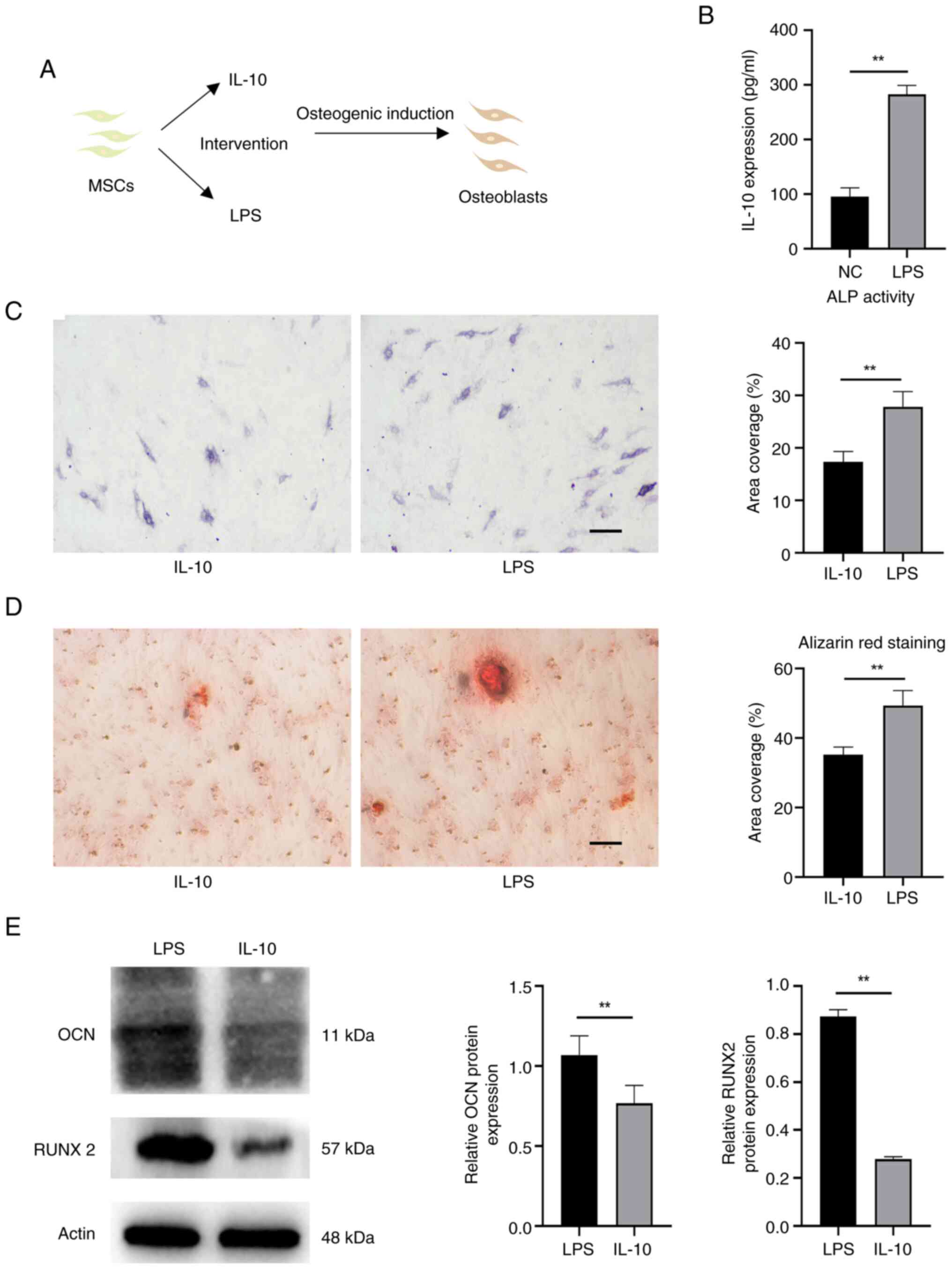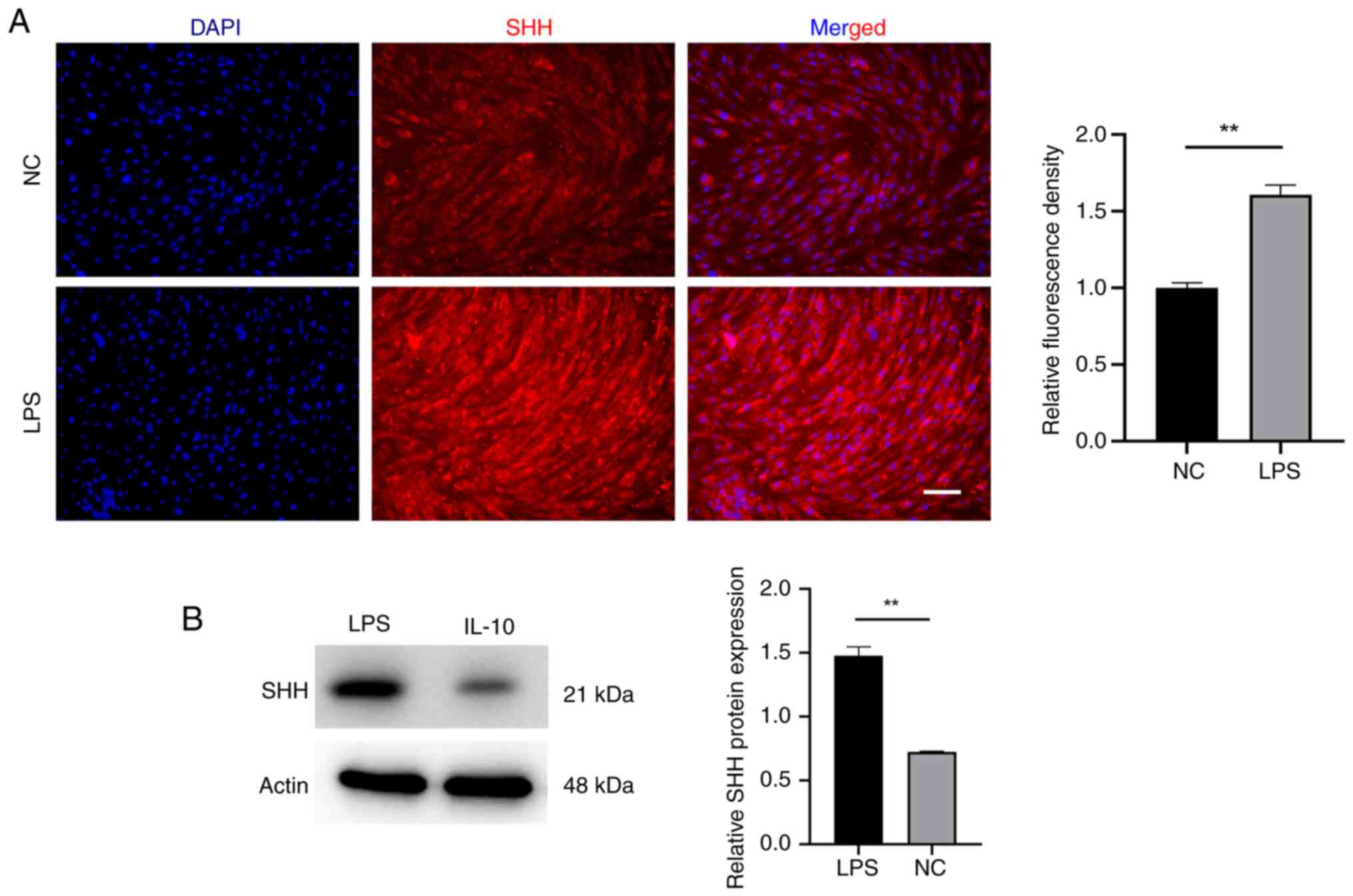LPS‑mediated adaptation accelerates ecto‑MSCs differentiation into osteoblasts
- Authors:
- Published online on: October 15, 2024 https://doi.org/10.3892/mmr.2024.13365
- Article Number: 241
-
Copyright: © Lv et al. This is an open access article distributed under the terms of Creative Commons Attribution License.
Abstract
Introduction
Bones provide structural support for the body and protect soft and vulnerable tissues and organs (1). With a rapidly aging population, the incidence of orthopedic clinical cases involving bone healing has been steadily increasing (2). Treating bone defects often involves nonunion, which seriously affects the patient's quality of life.
An increasing number of researchers have focused on tissue engineering for bone regeneration (3,4). While chitosan and other bioscaffolds have achieved considerable success in bone regeneration, the seed cells remain paramount (5,6). Mesenchymal stem cells (MSCs) possess the capacity for multidirectional differentiation and self-renewal, making them excellent candidate cells (7). MSCs may exert their effects through direct differentiation into bone cells or creating a regenerative environment through paracrine mechanisms (8–10). Ectodermal mesenchymal stem cells (EMSCs) represent a distinctive subset of MSCs originating from the neural crest stem cell (11). The neural crest stem cell plays a pivotal role in skull formation during early embryonic development (12,13). The majority of craniofacial bones are derived from the ectodermal germ layer, which is contributed by neural crest stem cell. These bones are notably different from the long bones derived from the mesoderm (14–16). Scientists have emphasized the osteogenic qualities of EMSCs and bone marrow mesenchymal stem cells (BMSCs). Noteworthy is their discovery that EMSCs exhibit superior proliferation characteristics when grown on three-dimensional scaffolds, highlighting the promising potential of EMSCs in tissue engineering endeavors (16). Prior investigations conducted in our laboratory also have demonstrated that the administration of EMSCs facilitates bone defect repair (17,18). However, the current inadequacy in the osteogenic differentiation capacity of EMSCs hinders their clinical application. Thus, there is a need for the development of more efficient and simplified therapeutic approaches to enhance the osteogenic differentiation potential of EMSCs.
The differentiation of MSCs into mature, functional osteoblasts represents a complex process intricately regulated and influenced by a number of factors. Alterations in the extracellular milieu can modulate cellular stress, consequently affecting the differentiation trajectory of MSCs (19). As an anti-inflammatory factor, IL-10 has recently been proved to have properties in regulating the osteogenic orientation of MSCs (20). Various inflammatory pretreatment methods applied to MSCs revealed clues suggesting enhancement of their immunological capabilities (21,22).
Though the enhanced immune effects remain complex, it is possible that IL-10 may emerge as a significant contributor to inflammatory preconditioning. Based on these foundations, it was hypothesized that our approach to inflammatory adaptation could augment the paracrine capabilities of EMSCs, leading to an upregulation in IL-10 levels and thereby facilitating significant osteogenic differentiation.
The present study aimed to determine whether the activation of EMSCs by lipopolysaccharide (LPS) enhances the process of osteogenesis and to delve deeper into the underlying mechanisms involved in this differentiation process. To achieve this objective, the present study conducted osteogenic differentiation assays to compare the behavior of EMSCs with that of LPS-activated EMSCs. Additionally, the expression of IL-10 in LPS-activated EMSCs was examined and IL-10 used as a positive control to assess its specific role. Previous studies have reported the osteogenic effect of IL-10 on MSCs (23,24). The aim of the present study was to ascertain whether LPS promoted osteogenic differentiation of ecto-MSCs by upregulating IL-10 and to compare the difference of EMSCs between the LPS and the IL-10 group. The findings carry implications for evaluating the osteogenic potential of EMSCs and underscore the significance of inflammatory adaption in the efficacy of MSC-based bone tissue engineering therapies.
Materials and methods
Cell culture
The human samples were obtained from anonymous healthy donors. Between March 2021 and December 2022, 10 volunteers ranging in age from 18–60 were recruited, maintaining an equal sex ratio of 1:1. All samples were collected with the donor's informed written consent. Permission for obtaining the samples was granted by the Affiliated Hospital of Jiangsu University (Zhenjiang, China; approval no. SWYXLI20190225-2). EMSCs were isolated from human nasal mucosa following previously established protocols with slight modifications. Briefly, mucosal tissues obtained from biopsies were finely minced and cultured in Dulbecco's modified Eagle's medium/nutrient mixture F12 (DMEM/F12) supplemented with 10% fetal bovine serum (FBS; HyClone; Cytiva). The tissues were maintained in a humidified incubator at 37°C with 5% CO2 and the medium was refreshed every 4 days. Upon outgrowth of cells, EMSCs were harvested using 0.25% trypsin and subcultured until reaching 85% confluence. The identity and purity of the cells were confirmed by immunofluorescence staining for nestin (Wuhan Boster Biological Technology, Ltd.), SRY-related HMG box-containing 9 (Sox9; Wuhan Boster Biological Technology, Ltd.) and vimentin (Wuhan Boster Biological Technology, Ltd.).
A total of 3,000 cells were evenly distributed into six-well plates and subjected to continuous culture until the emergence of discernible cell colonies. Following this incubation period, the plates underwent fixation at 4°C using a 4% paraformaldehyde solution for 15 min, followed by PBS washes. Subsequently, specimens were treated with a 0.1% crystal violet staining solution at room temperature, allowing for a 15-min staining period, after which they were rinsed with running water and images captured.
Inflammatory training of EMSCs
Cells were uniformly seeded in culture dishes at a density of 50% while in a favorable growth state. Prior to osteogenic induction, an inflammatory acclimation procedure was conducted. Briefly, EMSCs were cultured with low concentrations of LPS and incubated at 37°C in an incubator for five consecutive days. The stimulated medium was replaced every two days until the procedure was finished.
Calcein-AM/propidium iodide (PI) staining
The Calcein-AM/PI staining method was employed to distinguish between living and dead cells. Calcein-AM specifically stains living cells due to its ability to efficiently penetrate intact cell membranes, whereas PI selectively stains dead cells as it cannot traverse the intact cell membrane of living cells. The Calcein-AM/PI staining kit (Beijing Solarbio Science & Technology Co., Ltd.) was used following the manufacturer's protocol to assess the viability of EMSCs following LPS treatment. A solution containing 2 µM Calcein-AM and 1 µM PI was applied to the cells for 30 min at 37°C in a dark environment. Images were captured at 10× magnification using a fluorescence microscope.
Osteogenic differentiation of EMSCs in vitro
For osteogenic differentiation, EMSCs were cultured in osteogenic induction medium consisting of culture medium supplemented with 0.1 µM dexamethasone, 50 µg/ml ascorbic acid and 10 mM β-glycerophosphate. The medium was refreshed every 3 days over a 14-day period. Then, cells were fixed with 4% paraformaldehyde at RT for 10 min and subsequently stained with a 2% solution of Alizarin red S (Mackin Biochemical Co., Ltd.) for 10 min at room temperature. Meanwhile, alkaline phosphatase (ALP) staining was applied to EMSCs undergoing osteogenic differentiation to visualize the presence of osteoblasts. ALP activity was examined using an ALP staining kit (Beijing Solarbio Science & Technology Co., Ltd.) according to the manufacturer's protocol. The cells were stained for 30 min at RT and then imaged at 10× magnification with a light microscope, capturing five random fields of view.
Immunofluorescence staining
A total of 1×104 cells were seeded into 24-well plates and cultured in DMEM/F12 medium supplemented with 10% FBS (HyClone, Cytiva). For immunofluorescence staining, cells were fixed in 4% polyformaldehyde at 4°C overnight and then rinsed three times with PBS. Cells were permeabilized and blocked by a mixture of 0.1% Triton X-100 and 3% bovine serum albumin (BSA) for 30 min at RT. Following PBS washing, cells were incubated with primary antibodies targeting nestin, (1:100; Wuhan Boster Biological Technology, Ltd.) Sox9 (1:100; Wuhan Boster Biological Technology, Ltd.), Vimentin (1:100; Wuhan Boster Biological Technology, Ltd.), IL-10 (1:1,000; Wuhan Proteintech Biotechnology), Sonic hedgehog (Shh) (1:100; Wuhan Boster Biological Technology, Ltd.), Gli family zinc finger 1 (Gli1) and osteopontin (OPN) (1:100; Wuhan ProteinTech Biological Technology, Ltd.) at 4°C overnight. After PBS washing, cells were incubated with Cy3-conjugated secondary antibodies at 37°C for 1 h. Nuclear staining was performed by incubating the cells with DAPI at room temperature for 10 min and observation was conducted using fluorescence microscopy at 10× magnification.
Western blotting
Cell protein was extracted with RIPA lysis buffer (Biosharp Life Sciences) supplemented with protease inhibitors (Wuhan Boster Biological Technology, Ltd.). The protein concentration of the samples was measured using the BCA assay. A total of 3 µg protein was loaded into each lane, separated via 10% SDS-PAGE) and transferred onto a polyvinylidene fluoride membrane. Following a 1 h blocking step with 5% BSA (Biosharp, China) at RT, the membranes were incubated with primary antibodies against Shh (1:1,000; BA2171; Wuhan Boster Biological Technology, Ltd.), IL-10 (1:1,000; 60269-1-Ig; Wuhan Proteintech Biotechnology), Osteocalcin (OCN; 1:1,000; 20277-1-AP; Wuhan ProteinTech Biotechnology), Runt-related transcription factor 2 (1: 1,000; 20700-1-AP; Wuhan Proteintech Biotechnology) and Actin (1:1,000; bsm-33036M; BIOSS) for an hour at RT. Subsequently, HRP-conjugated goat anti-rabbit IgG (1:5,000; BA1058; Wuhan Boster Biological Technology, Ltd.) was applied and incubated with the membrane for 1 h at 37°C. Immunoreactive bands were visualized using enhanced chemiluminescence reagents (Millipore; Sigma). The bands was quantified by ImageJ (version 1.8.0; NIH) software.
ELISA
Cell supernatant was harvested, followed by centrifugation at 2,500 × g at room temperature for 10 min to remove residual cells and debris. An IL-10 ELISA kit purchased from Boster (Cat. no. EK0416) was used to analyze the sample following the instructions and its absorbance at 450 nm was quantified using a microplate reader.
Statistical analysis
Statistical analyses were performed using GraphPad software (version 8.0.2; Dotmatics). All data are presented as the mean ± standard deviation. The significance of differences between groups was assessed using two-tailed unpaired Student's t-test or one-way analysis of variance with Bonferroni method. P<0.05 was considered to indicate a statistically significant difference.
Results
EMSCs isolation and characterization
The nasal musca were cut into pieces (1 mm2) and cultured into plates (Fig. 1A). Initially, it was observed that EMSCs migrated from the tissue (Fig. 1B) and that they proliferated rapidly after several subculture passages (Fig. 1C).
Identification of surface markers of EMSCs
Next, the expression of EMSCs markers (nestin, Sox9, vimentin) was evaluated through immunofluorescence staining. As illustrated in Fig. 2, neuroectodermal lineage marker (nestin), MSCs marker (vimentin) and neural crest-related marker (Sox9) were detected, which is consistent with our previous findings (25,26).
Influence of inflammatory adaptation on EMSCs
To evaluate whether inflammatory adaptation affects the survival of EMSCs, live (green)/dead (red) cell staining was performed. The results indicated that the five consecutive training days with varying concentrations of LPS resulted in distinct performances regarding the cell survival rate. Specifically, exposure to 100 ng/ml LPS appeared to have no detrimental effect on EMSCs, whereas exposure to 1 µg/ml LPS induced certain damage (Fig. 3).
Inflammatory adaptation procedure improves IL-10 expression of EMSCs
Next, immunofluorescence and western blotting were conducted to assess whether inflammatory adaptation procedure would elevate the levels of IL-10 in EMSCs (Fig. 4). The findings indicated a notable increase in IL-10 expression in EMSCs, demonstrating significant differences. Immunofluorescence analysis also revealed an enhanced IL-10 fluorescence signal in the LPS group. During domestication, the dynamic alternation of IL-10 in EMSCs indicated a positive outlook for anti-inflammatory therapy and hinted at an increased potential for osteogenic differentiation (20,27).
Inflammatory adaptation of EMSCs enhances osteogenic differentiation
Based on the aforementioned studies, it was investigated whether the elevated levels of IL-10 affected osteogenic differentiation. Alizarin red staining can detect calcium deposits as a marker to confirm successful osteoblastic differentiation of stem cells. EMSCs domesticated by LPS obtained an enhanced osteogenic characteristic (Fig. 5A). The ALP staining results also corroborated this observation (Fig. 5B). Meanwhile, the expression of Gli1 and OPN as indicators of osteogenic-related proteins was test. As shown in Fig. 6, EMSCs exposed to LPS exhibited high levels of expression of (A) Gli1 and (B) OPN.
Unraveling factors beyond IL-10 in promoting EMSCs osteogenic differentiation during inflammatory adaptation
IL-10 can enhance the osteogenic differentiation of MSCs (23). In order to investigate whether the heightened osteogenic induction following inflammatory acclimation was primarily attributed to the increase in IL-10, cells treated solely with IL-10 were allocated into a control group (Fig. 7A). Briefly, IL-10 expression was measured in the inflammatory adaptation of EMSCs by ELISA (Fig. 7B). The IL-10 level acted as a benchmark, prompting the introduction of the corresponding IL-10 factor for intervention. Fig. 7C showed that ALP activity in the LPS group was also higher compared with the IL-10 group. The LPS group exhibited a higher prevalence of calcium deposits (Fig. 7D). The high expression of proteins, such as OCN and RUNX2, further confirmed these phenomena (Fig. 7E).
Shh contributes to EMSCs osteogenic differentiation during inflammatory adaptation
The question is what leads to the outstanding osteogenic differentiation potential observed in inflammatory-acclimated EMSCs? Is it simply the upregulation of IL-10? Shh serves as a morphogen regulating skeletal and vascular development in embryos (28). Research has documented its beneficial impact on fostering osteogenic differentiation (29). For this reason, the expression of Shh in EMSCs under the inflammatory adaptation was further detected. Notably, the results showed that the evaluated expression of Shh was also triggered by LPS (Fig. 8). Domestication is a complex process influenced by various factors, including cellular stress. This discovery suggested that Shh could act as an additional facilitator in osteogenic differentiation, highlighting the need for further investigation into other contributing factors.
Discussion
The process of domesticating EMSCs, a novel and intriguing approach, has the potential to alter numerous properties of EMSCs. Inflammatory adaptation, a unique model of adaptation characterized by its heightened anti-inflammatory attributes, raises new considerations. However, the reported absence of osteogenic induction in these domesticated MSCs, with the underlying mechanisms of induction remaining unclear, presents a significant gap in our understanding. The present study aimed to fill this gap by exploring the effect of inflammatory adaptation on MSC differentiation into osteoblasts and elucidating potential underlying mechanisms.
LPS can trigger inflammation in MSCs, elevate levels of oxidative stress, induce ROS generation, disrupt mitochondrial function and induce various metabolic changes. These detrimental effects impede the osteogenic differentiation process of MSCs (30,31). However, the varying outcome primarily relies on the concentration of LPS and the specific type of cell affected. A previous investigation, with LPS concentrations reaching 1 µg/ml, led to potential harm to MSCs, ultimately impeding their osteogenic differentiation (32). The present study also confirmed that exposure to LPS at a concentration of 1µg/ml could harm EMSCs, prompting the selection of a lower concentration of LPS. Thus, a unique approach to acclimate to the low-concentration stimulation pattern over time was implemented, diverging from prior research methodologies. Notably, the present study indicated that EMSCs osteogenesis is expedited by inflammatory adaptation. Meanwhile, it was discovered that the osteogenic capability was initiated by the heightened secretion of IL-10, a cytokine abundantly expressed in the acclimated EMSCs, thereby enhancing the osteogenic differentiation of EMSCs. IL-10 is crucial as an immunomodulatory agent and an osteoblastogenic cytokine. The elevation of IL-10 undoubtedly hastens the osteogenesis process. Hence, the process of inflammatory adaptation not only enables EMSCs to acquire immunomodulatory properties but also facilitates their osteogenic potential. Further investigation is needed to determine if endoplasmic reticulum stress triggered by LPS is the most plausible explanation for this phenomenon (33).
Furthermore, the present study employed an equivalent concentration of IL-10 to stimulate osteogenesis, yet it failed to yield the marked osteogenic outcomes observed with EMSCs post-inflammatory adaptation. It was hypothesized that the inflammatory adaptation process imbued EMSCs with a complex network of osteogenic factors, albeit poorly elucidated. Shh, a morphogenetic factor, frequently influences the osteogenic differentiation of stem cells through its expression (34,35). The present study conducted a preliminary examination of Shh expression in EMSCs acclimated by LPS and the results also indicated an observed increase in expression in EMSCs. It was provisionally verified that the inflammatory adaptation of EMSCs induced alterations in factor metabolism levels and these modifications within the factor network facilitated the transition of EMSCs into osteoblasts. However, the present study only demonstrated the positive involvement of IL-10 and Shh in promoting osteogenic differentiation in EMSCs under inflammatory adaption, while a number of other factors contributing to osteogenic differentiation remain unexplored. It is necessary to further investigate the effect of inflammatory adaptation on EMSCs and elucidate the signaling pathways through which these effects promote osteogenesis. Biological scaffolds also play a pivotal role in bone regeneration (36,37). Fully understanding tissue engineering requires the close integration of cells with scaffolds. Research interest in chitosan and its derivatives has surged because of their remarkable biocompatibility and biodegradability. Chitosan has been proved to be a highly effective scaffold material in numerous applications within the realm of bone regeneration, demonstrating notable success (38,39). Integrating bioengineered scaffolds such as chitosan with MSCs may also provide a promising perspective for advancement.
In summary, the present study indicated that EMSCs developed a multifactorial network through inflammatory adaptation, highlighted by IL-10 and Shh, which enhanced their osteogenic capabilities. This significant finding not only deepens our understanding of the osteogenic differentiation process but also opens up new avenues for the development of novel approaches to treat bone defects in the future, potentially revolutionizing the field of regenerative medicine. However, the present study also encountered some new challenging questions, including what concentration of LPS can break the adaptive changes and turn into toxic damage and whether these cell-level changes are caused by ER stress. These intriguing inquiries require further examination.
Acknowledgements
Not applicable.
Funding
The present study received support from the Scientific research project of Health Commission of Jiangsu, China (grant no. H2023141).
Availability of data and materials
The data generated in the present study may be requested from the corresponding author.
Author's contributions
DL was responsible for conceptualization, design, operation and drafting and revising the manuscript. DL, ZL and BL revised the manuscript. BL, QZ and ZZ analyzed and interpreted data. SC and YX were responsible for organization, conceptualization, analysis and revision. ZL collected human samples and validated data sets to guarantee their integrity and accuracy. All authors reviewed and approved the final manuscript. DL and BL confirm the authenticity of all the raw data.
Ethics approval and consent to participate
The experimental protocol was approved by the Ethical Committee of the Affiliated Hospital of Jiangsu University (Jiangsu, China; approval. SWYXLI20190225-2).
Patient consent for publication
Not applicable.
Competing interests
The authors declare that they have no competing interests.
References
|
Rayat Pisheh H, Ansari M and Eslami H: How is mechanobiology involved in bone regenerative medicine? Tissue Cell. 76:1018212022. View Article : Google Scholar : PubMed/NCBI | |
|
Dec P, Modrzejewski A and Pawlik A: Existing and novel biomaterials for bone tissue engineering. Int J Mol Sci. 24:5292022. View Article : Google Scholar : PubMed/NCBI | |
|
Li S, Liu J, Liu S, Jiao W and Wang X: Chitosan oligosaccharides packaged into rat adipose mesenchymal stem cells-derived extracellular vesicles facilitating cartilage injury repair and alleviating osteoarthritis. J Nanobiotechnology. 19:3432021. View Article : Google Scholar : PubMed/NCBI | |
|
Li S, Tian X, Fan J, Tong H, Ao Q and Wang X: Chitosans for tissue repair and organ three-dimensional (3D) bioprinting. Micromachines (Basel). 10:7652019. View Article : Google Scholar : PubMed/NCBI | |
|
Yuan G, Li Z, Lin X, Li N and Xu R: New perspective of skeletal stem cells. Biomater Transl. 3:280–294. 2022.PubMed/NCBI | |
|
Benayahu D: Mesenchymal stem cell differentiation and usage for biotechnology applications: Tissue engineering and food manufacturing. Biomater Transl. 3:17–23. 2022.PubMed/NCBI | |
|
Charbord P: Bone marrow mesenchymal stem cells: Historical overview and concepts. Hum Gene Ther. 21:1045–1056. 2010. View Article : Google Scholar : PubMed/NCBI | |
|
Wang D, Cao H, Hua W, Gao L, Yuan Y, Zhou X and Zeng Z: Mesenchymal stem cell-derived extracellular vesicles for bone defect repair. membranes (basel). 12:7162022. View Article : Google Scholar : PubMed/NCBI | |
|
Li S, Liu J, Liu S, Jiao W and Wang X: Mesenchymal stem cell-derived extracellular vesicles prevent the development of osteoarthritis via the circHIPK3/miR-124-3p/MYH9 axis. J Nanobiotechnology. 19:1942021. View Article : Google Scholar : PubMed/NCBI | |
|
Lin H, Sohn J, Shen H, Langhans MT and Tuan RS: Bone marrow mesenchymal stem cells: Aging and tissue engineering applications to enhance bone healing. Biomaterials. 203:96–110. 2019. View Article : Google Scholar : PubMed/NCBI | |
|
Delorme B, Nivet E, Gaillard J, Häupl T, Ringe J, Devèze A, Magnan J, Sohier J, Khrestchatisky M, Roman FS, et al: The human nose harbors a niche of olfactory ectomesenchymal stem cells displaying neurogenic and osteogenic properties. Stem Cells Dev. 19:853–866. 2010. View Article : Google Scholar : PubMed/NCBI | |
|
Patthey C, Schlosser G and Shimeld SM: The evolutionary history of vertebrate cranial placodes-I: Cell type evolution. Dev Biol. 389:82–97. 2014. View Article : Google Scholar : PubMed/NCBI | |
|
Diogo R, Kelly RG, Christiaen L, Levine M, Ziermann JM, Molnar JL, Noden DM and Tzahor E: A new heart for a new head in vertebrate cardiopharyngeal evolution. Nature. 520:466–473. 2015. View Article : Google Scholar : PubMed/NCBI | |
|
Achilleos A and Trainor PA: Neural crest stem cells: Discovery, properties and potential for therapy. Cell Res. 22:288–304. 2012. View Article : Google Scholar : PubMed/NCBI | |
|
Trainor PA: Craniofacial birth defects: The role of neural crest cells in the etiology and pathogenesis of Treacher Collins syndrome and the potential for prevention. Am J Med Genet A. 52A:2984–2994. 2010. View Article : Google Scholar : PubMed/NCBI | |
|
Srinivasan A, Teo N, Poon KJ, Tiwari P, Ravichandran A, Wen F, Teoh SH, Lim TC and Toh YC: Comparative craniofacial bone regeneration capacities of mesenchymal stem cells derived from human neural crest stem cells and bone marrow. ACS Biomater Sci Eng. 7:207–221. 2021. View Article : Google Scholar : PubMed/NCBI | |
|
Shi W, Zhang X, Bian L, Dai Y, Wang Z, Zhou Y, Yu S, Zhang Z, Zhao P, Tang H, et al: Alendronate crosslinked chitosan/polycaprolactone scaffold for bone defects repairing. Int J Biol Macromol. 204:441–456. 2022. View Article : Google Scholar : PubMed/NCBI | |
|
Shi W, Bian L, Wu Y, Wang Z, Dai Y, Zhou Y, Meng P, Wang Q, Zhang Z, Zhao X, et al: Enhanced bone regeneration using a ZIF-8-Loaded fibrin composite scaffold. Macromol Biosci. 22:e21004162022. View Article : Google Scholar : PubMed/NCBI | |
|
Li S, Wang J, Han Y, Li X, Liu C, Lv Z, Wang X, Tang X and Wang Z: Carbenoxolone inhibits mechanical stress-induced osteogenic differentiation of mesenchymal stem cells by regulating p38 MAPK phosphorylation. Exp Ther Med. 15:2798–2803. 2018.PubMed/NCBI | |
|
Yuan L, You H, Qin N and Zuo W: Interleukin-10 modulates the metabolism and osteogenesis of human dental pulp stem cells. Cell Reprogram. 23:270–276. 2021. View Article : Google Scholar : PubMed/NCBI | |
|
Su W, Wan Q, Huang J, Han L, Chen X, Chen G, Olsen N, Zheng SG and Liang D: Culture medium from TNF-α-stimulated mesenchymal stem cells attenuates allergic conjunctivitis through multiple antiallergic mechanisms. J Allergy Clin Immunol. 136:423–432.e8. 2015. View Article : Google Scholar : PubMed/NCBI | |
|
Liu H, Zhu X, Cao X, Chi A, Dai J, Wang Z, Deng C and Zhang M: IL-1β-primed mesenchymal stromal cells exert enhanced therapeutic effects to alleviate Chronic Prostatitis/Chronic Pelvic Pain Syndrome through systemic immunity. Stem Cell Res Ther. 12:5142021. View Article : Google Scholar : PubMed/NCBI | |
|
Vallés G, Bensiamar F, Maestro-Paramio L, García-Rey E, Vilaboa N and Saldaña L: Influence of inflammatory conditions provided by macrophages on osteogenic ability of mesenchymal stem cells. Stem Cell Res Ther. 11:572020. View Article : Google Scholar : PubMed/NCBI | |
|
Mahon OR, Browe DC, Gonzalez-Fernandez T, Pitacco P, Whelan IT, Von Euw S, Hobbs C, Nicolosi V, Cunningham KT, Mills KHG, et al: Nano-particle mediated M2 macrophage polarization enhances bone formation and MSC osteogenesis in an IL-10 dependent manner. Biomaterials. 239:1198332020. View Article : Google Scholar : PubMed/NCBI | |
|
Shi W, Que Y, Lv D, Bi S, Xu Z, Wang D and Zhang Z: Overexpression of TG2 enhances the differentiation of ectomesenchymal stem cells into neuron-like cells and promotes functional recovery in adult rats following spinal cord injury. Mol Med Rep. 20:2763–2773. 2019.PubMed/NCBI | |
|
Shi W, Bian L, Lv D, Bi S, Dai Y, Yang K, Lu H, Zhou H, Que Y, Wang D, et al: Enhanced neural differentiation of neural stem cells by sustained release of Shh from TG2 gene-modified EMSC co-culture in vitro. Amino Acids. 53:11–22. 2021. View Article : Google Scholar : PubMed/NCBI | |
|
Ouyang W, Rutz S, Crellin NK, Valdez PA and Hymowitz SG: Regulation and functions of the IL-10 family of cytokines in inflammation and disease. Annu Rev Immunol. 29:71–109. 2011. View Article : Google Scholar : PubMed/NCBI | |
|
Fuchs S, Dohle E and Kirkpatrick CJ: Sonic Hedgehog-mediated synergistic effects guiding angiogenesis and osteogenesis. Vitam Horm. 88:491–506. 2012. View Article : Google Scholar : PubMed/NCBI | |
|
Ma D, Yu H, Xu S, Wang H, Zhang X, Ning T and Wu B: Stathmin inhibits proliferation and differentiation of dental pulp stem cells via sonic hedgehog/Gli. J Cell Mol Med. 22:3442–3451. 2018. View Article : Google Scholar : PubMed/NCBI | |
|
Bai Y, Zhang W, Hao L, Zhao Y, Tsai IC, Qi Y and Xu Q: Acetyl-CoA-dependent ac4C acetylation promotes the osteogenic differentiation of LPS-stimulated BMSCs. Int Immunopharmacol. 133:1121242024. View Article : Google Scholar : PubMed/NCBI | |
|
Huang Z, Chen G, Wu H, Huang X, Xu R, Deng F and Li Y: Ebselen restores peri-implantitis-induced osteogenic inhibition via suppressing BMSCs ferroptosis. Exp Cell Res. 427:1136122023. View Article : Google Scholar : PubMed/NCBI | |
|
Amarasekara DS, Kim S and Rho J: Regulation of osteoblast differentiation by cytokine networks. Int J Mol Sci. 22:28512021. View Article : Google Scholar : PubMed/NCBI | |
|
Zhang SX, Wang JJ, Starr CR, Lee EJ, Park KS, Zhylkibayev A, Medina A, Lin JH and Gorbatyuk M: The endoplasmic reticulum: Homeostasis and crosstalk in retinal health and disease. Prog Retin Eye Res. 98:1012312024. View Article : Google Scholar : PubMed/NCBI | |
|
Takebe H, Shalehin N, Hosoya A, Shimo T and Irie K: Sonic hedgehog regulates bone fracture healing. Int J Mol Sci. 21:6772020. View Article : Google Scholar : PubMed/NCBI | |
|
Guan CC, Yan M, Jiang XQ, Zhang P, Zhang XL, Li J, Ye DX and Zhang FQ: Sonic hedgehog alleviates the inhibitory effects of high glucose on the osteoblastic differentiation of bone marrow stromal cells. Bone. 45:1146–1152. 2009. View Article : Google Scholar : PubMed/NCBI | |
|
Wang Y, Zhang H, Hu Y, Jing Y, Geng Z and Su J: Bone repair biomaterials: A perspective from immunomodulation. Adv Funct Mater. 32:22086392022. View Article : Google Scholar : PubMed/NCBI | |
|
Wang F, Gu Z, Yin Z, Zhang W, Bai L and Su J: Cell unit-inspired natural nano-based biomaterials as versatile building blocks for bone/cartilage regeneration. J Nanobiotechnology. 21:2932023. View Article : Google Scholar : PubMed/NCBI | |
|
Zhang S, Zhao G, Mahotra M, Ma S, Li W, Lee HW, Yu H, Sampathkumar K, Xie D, Guo J and Loo SCJ: Chitosan nanofibrous scaffold with graded and controlled release of ciprofloxacin and BMP-2 nanoparticles for the conception of bone regeneration. Int J Biol Macromol. 254((Pt 2)): 1279122024. View Article : Google Scholar : PubMed/NCBI | |
|
Liu G, Ma M, Yang H, He W, Xie Y, Li J, Li J, Zhao F and Zheng Y: Chitosan/polydopamine/octacalcium phosphate composite microcarrier simulates natural bone components to induce osteogenic differentiation of stem cells. Biomater Adv. 154:2136422023. View Article : Google Scholar : PubMed/NCBI |



